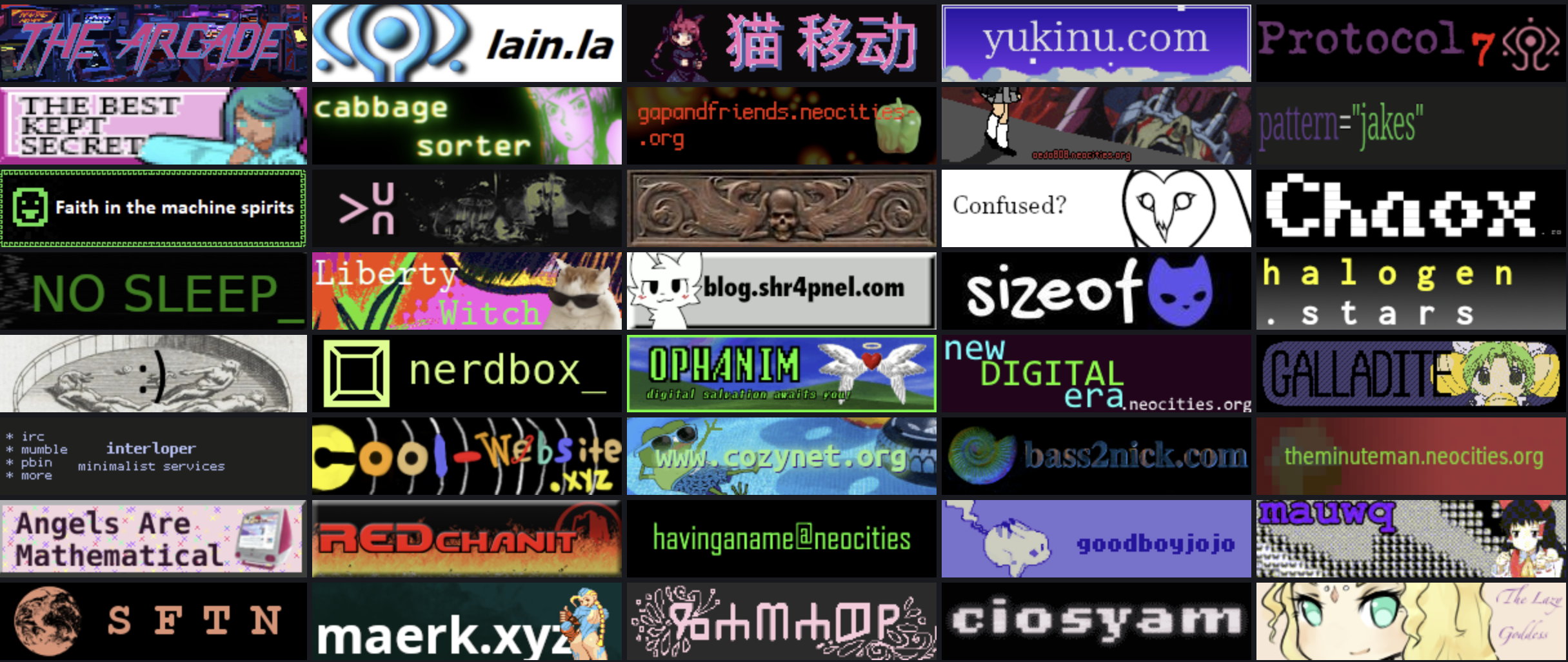The Webrings Renaissance
Ever heard of a webring?
Back in the late 90s/early 2000s, before the days of social media and mass adoption of search engines, it was much harder to find content on the web. It might be hard to imagine in this day and age where everyone has terabytes worth of content within reach at all times. In those early days of the internet, the “web” wasn’t nearly as webbed as it is now. Websites were difficult to build and required technical know-how to deploy so there were far fewer sites than there are today. So how did one find websites they didn’t know about once they logged on to the internet?
The history of webrings
" Welcome to WebRing, one of the fastest and most exciting ways to navigate the World Wide Web! This completely free service offers easy access to hundreds of thousands of member websites organized by related interests into easy-to-travel Rings. “
Webring.org was a software company that provided a platform for websites to form a “ring”. Usually ring members were small personal sites or blogs, and all contained content of a similar theme. They were created and managed by a moderator (the “Ringmaster”) who could add or remove members from the ring through the platform. Website administrators could join a ring, after which, they would be required to include a script on their site that would load into the site with banner gifs and links to all the other sites in the ring. This made it easier for someone to explore other sites in the ring, increasing each sites chance of being viewed. Thousands of rings were listed, some of which contained tens of thousands of sites. Here’s a snapshot of the site from 1999.
 The webring.org logo, 1999
The webring.org logo, 1999
Yahoo killed the webring
Through a series of acquisitions, webring.org fell into the hands of Yahoo! in 1999. After the acquisition, Yahoo made a number of changes to webring.org that inevitably would lead to its demise. Firstly, they integrated webring.org into Yahoo.com and when doing so, introduced a flaw that allowed anyone to claim an existing webring just by logging into it first. This meant many ringmasters lost their webrings. Secondly, Yahoo redesigned the flow of how one could navigate between sites on a ring by directing users back to Yahoos webring page where they would be served ads. This went against the very idea of webrings as a decentralized and free way to navigate the web.
In 2001, the webrings site was abandoned by Yahoo, and sold to one of the original creators of the site. He would maintain it for years after, but it never quite regained its original glory now that search engines were becoming widely adopted.
After webrings.org shut down, users continued to maintain their own rings in a more informal fashion, without a centralized platform. This unfortunately made it harder to find webrings, since there was now no longer a directory of rings to browse through. Inevitably, webrings seemed to fade into the 1s and 0s of the internet; forgotten except for the few netizens who experienced it for a brief point in time when the internet was wild and free.
Our Modern Web
Over the next few decades, webrings were left behind as social media and search engines became the de-facto entrypoints into the internet. Content was everything, everywhere, all at once. The internet modernized; became easier to access, faster and more user-friendly. The basic HTML and CSS sites with bright colors, animated gifs and image buttons were replaced by the clean, flat interfaces of the new web.
Search engines became engines for profit, where only sites that could master the search engine optimization algorithms could remain relevant on the web. These changes enabled the system that we have now, where despite the internet being infinitely massive and more accessible than ever, we only get to see a small portion of it. Not to mention the rise of AI generated content that has flooded the web over the last few years, making content on the web feel even more artificial and impersonal.
Nostalgic for the old web
Subjectively, I believe that this over-commercialization of the web has led to many members of the early days of the web feeling nostalgic for times without cookie consent banners and personalized ads.
It’s understandable to feel like the original principles of the webrings have become rare, rather than commonplace. That of the web being a space for one to express themselves in unique and interesting ways. For these reasons, I believe, it appears that webrings may be making a comeback.
The Re-emergence of Webrings
15 years later, an eternity in internet culture years, new open source webring projects were built and released online for free. The ringmasters of the old internet, or perhaps new aspiring webring enthusiasts that are feeling nostalgic for a simpler time, begin to create and share their own webring scripts and publish them on online code repositories. From 2015 on, there is a resurgeance of activity on open source webring projects. The number of new projects grows year after year with an explosion of activity in 2022. Currently, there are hundreds of open source projects that independent ringmasters can use to maintain their webrings. New sites began to pop up, catalogueing rings to make them easier to find. Forums dedicated to webrings began to see a surge of new discussions: how to create a personal site, how to find webrings, and how to join one.
 Onionring.js, one of the most used, free and decentralized webring managers
Onionring.js, one of the most used, free and decentralized webring managers
It was an amazing thing to see. Dozens of rings and hundreds of sites. Spawning out of the shared principles of rejecting the over-commercialized internet, and returning it to a place of expressive creativity. These niche communities had found a method to thrive together in their small, obscure nook on the internet.
True freedom on the internet
I was amazed when I stumbled upon this, instantly transported back to when I was a youngster during the early 2000s. These communities had not only revived the idea of webrings, they had embraced it in its original form: banner gifs, unique and unruly website styles, and free of ads and tracking. After living on the modern web for so long, it almost feels freeing to find an area of the web that isn’t plagued by commercialization and mass tracking. An area filled with amazing artists and writers that aren’t selling something. Where the point of the site is pure expression rather than something built for commercial gain. Not to mention that you could spend hours navigating these sites without ever having to leave the ring. A web experience completely detached from what the web has become.

The “Small Web”
One site labeled it in a way I found incredibly appropriate. The author called it the “Small Web”. This doesn’t appear to be a new term by any means, but it’s the first time I’ve heard of it. It is essentially:
the part of the web that’s built for and by individuals.
These sites are much more personal and creative than the sites we might find through Google or social media. Webmasters are passionate about using the internet as a medium of expression, whether that’s through sharing writing, journaling, art, music or anything else in between.
Webrings are a core part of this alternative corner of the internet because they link the communities together, allowing visitors to get access to original and creative content without needing to go back to the “Big Web”.
The small web provides access to beautifully unique and creative side of the internet. Once you visit one, you’ll be shown links to other interesting sites. Then that link will take you to a site with more links, and even more webrings. Some sights maintain their own personal collection of small web sites as well. Each site you visit makes this community of indie webmasters seem bigger and bigger.
Neocities powers the small web
Many of these sites appear to be hosted on Neocities. Neocities is an open-source platform for hosting personal sites. But Neocities is more than that; there are plenty of free hosting providers on the web. What Neocities represents, I believe, is a set of values by which all of its users believe in. It has fostered a culture that has potentially been the underlying foundation for the concepts of the Small Web for some time now. Just browse through the Neocities directory and you’ll find all sorts of amazingly creative sites.

The more I dove into this rabbit hole, the more I realized just how big it was. Thousands and thousands of sites, all accessible through a decentralized web of links. No Google, no Facebook and no Twitter. Just individuals hosting sites and deciding to link to other sites they like.
The Future of the Small Web
It’s hard to say for certain what lies ahead for the Small Web. I’d like to think that the more tools available would make the Small Web more accessible than ever. It’s easier than ever to host a personal website or blog, even if you have very little experience with coding or building websites. It’s also easier to learn than ever with the amount of educational content available online for free (there’s plenty of information about this on the Small Web itself).
On the other hand, rather cynically, perhaps the rise of AI generated content and the continued centralization of the web into the hands of only a few large corporations could suffocate the Small Web into obscurity.
All I can say is that I hope to see the Small Web and the concepts behind the Web Revival grow and thrive. These movements may seem small and niche but they carry important messages about the state of the internet that is an ever-growing part of our lives. In the meantime, I’ll continue to browse and support the Small Web however I can and if you’ve gotten this far in this post, I hope I’ve inspired you to do the same.